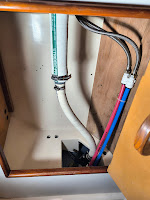The weather is getting colder, but I keep finding excuses to start a new boat project. In reality, I'm having fun and unlike last year when I rebuilt the Westerbeke over the winter, I'm a little worried that I'm going to run out of things to do this winter. The majority of the systems are installed and it won't be long before it will be too cold and snowy to work on the boat, so I'm doing a bit of hunting around to find a few projects that I can do in my shop over the winter.
I can't really get going on the rigging work because I'm going to have to spend a bunch of quality time with the old standing rod rigging laid out at the mast to get accurate measurements for the new wire rigging and I'd really rather not have frozen fingers for that. It can wait till spring. However, I was standing by the mast the other day pondering how I was going to get the new radio antenna wire snaked out the side of the mast up near the masthead when I noticed that it looked like the masthead was removable.
After consulting with the Niagara 35 Owner's Group on Facebook, I decided that this would make for a good project if I could get it off the mast. The sheaves are probably pretty tired and I could have new ones made and replace them over the winter and clean up the masthead. The question however, was whether or not the assembly was fused to the mast from years of sitting outside or if somebody had decided to glue it all together with 3M 5200.Today happened to be pretty nice, so I figured I'd give it a shot. There were 3-7/16" stainless steel bolts on each side holding the assembly to the mast, and I was pleasantly surprised that every single one of them freed up without any difficulty at all. The only problem I had was that someone had installed the radio antenna bracket very close to one of them and had to switch to an open ended wrench to get that one off because there wasn't room to get the socket on.
Once I had all the bolts out, I gave the assembly a tap and was really surprised when it actually moved and wasn't corroded to the mast. Stainless steel and aluminum don't mix very well when wet and if you don't apply an anti-seize compound (Tef-Gel is one brand) when you thread in the stainless bolt, you can end up with a corroded mess and the aluminum always loses. Somebody clearly installed this the right way.
As I pulled the masthead out, I labeled the substitute halyards and took a bunch of photos so I could reverse the process when I reinstalled. Honestly, I couldn't believe my good luck. Boat projects never take just 1 hour with no swearing so I'll chalk this one up as decidedly pleasant. I haven't pulled the sheaves out yet or inspected them closely, but I will probably replace them for good measure regardless of condition (TBD). The big bonus for this effort is that it will make rewiring the top of the mast infinitely easier.
UPDATE: I took apart the masthead this morning and was pleased to see very little wear on the sheaves themselves, the bronze journal bearings, or the stainless steel axles. The axles fit snugly through the journal bearings with no play. The sheave themselves are a combination wire/rope sheave with a groove in the bottom to accommodate wire, but it was clearly never used, so looks to be a rope only boat (unless these sheaves have been replaced at some point). So I guess this is one area I won't have to spend money for replacements. I cleaned everything up, re-greased the axels with lithium grease and put it all back together.


















































